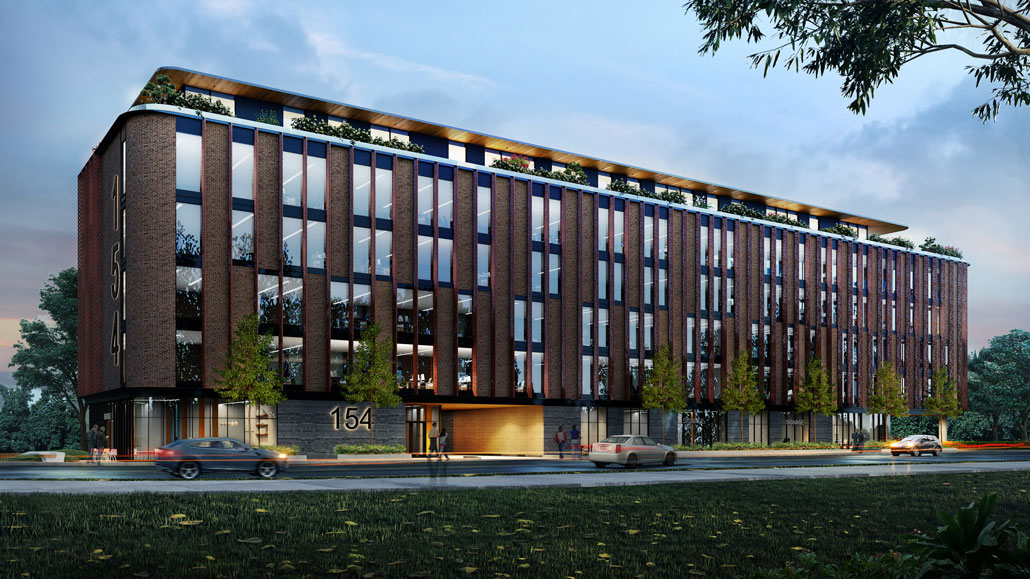
After more than five years navigating the challenges and red tape that has become the building approval process in the City of Toronto, the stunning architectural design of the Class A building proposed for 154 Wicksteed Ave. is nearing its final stage of approval by City Council. If approved in May, Colliers and Lennard Commercial Real Estate will begin marketing and the new Leaside Innovation Centre should be the first mass timber flatiron building in Canada, opening its doors for business in 2024.
This would be welcome news for business partners Peter Schultz (Leaside Life, July 2020) and Charles Goldsmith, the team redeveloping the site, named the Leaside Innovation Centre (https://leasideinnovationcentre.com). Their plans for a six-storey flatiron office building will create one of the first structures in Toronto to take advantage of changes to the Ontario building code that permit heavy timber structures up to six storeys. The result is a design incorporating engineered wood elements throughout. Greg Latimer, principal of studioCANOO and a member of the design team, said, “In 2017 we proposed a mass timber structural system to the client. They were immediately intrigued by the possibility of recreating a contemporary version of the highly desirable 19th century warehouses that dot the downtown core.”
Mass timber: healthier built environment for workers
Mass timber uses state-of-the-art technology to create thick, compressed layers of wood resulting in strong, structural load-bearing panels, posts, and beams. With similar strength to concrete and steel, mass timber is a lightweight, safe, environmentally friendly alternative to carbon-intensive materials and building systems supporting a physically and psychologically healthier built environment for workers. “Everyone loves a flatiron,” gushes Goldsmith, and “research shows that modern healthy buildings designed with wellness and wellbeing in mind improve productivity.”
As someone interested in the revitalization of Leaside’s employment zone, this project has been on my radar since I first wrote about it three years ago. At the time, I felt this project would serve as a catalyst for commercial rejuvenation, bringing, as I wrote, “400 new future-proof higher paying jobs” to our community. In addition to jobs, the building would also: (1) serve as an attractive gateway into the business park, (2) help address the awkward and potentially dangerous traffic issues at that intersection, (3) add a 2,500-sq. ft. parkette that the City will not be required to maintain, and (4) encourage other property owners or potential investors to consider the synergy that could be created if Leaside evolved into a vibrant employment zone befitting the type of work associated with the fourth industrial revolution.
Approval of this project couldn’t come at a more opportune time. In November, I wrote about “The future of employment lands in Leaside,” noting that the City was currently conducting its Municipal Comprehensive Review (MCR) and Growth Plan conformity exercise in order to accommodate a projected need to create homes for 700,000 new residents and 450,000 new jobs in Toronto. Further complicating the exercise is the fact that the City is currently addressing several conversion requests in Leaside that would see designated employment lands rezoned for non-employment uses such as residential.
The erosion of employment lands in Leaside remains a risk
The Ontario government recently released its Housing Affordability Task Force Report (https://files.ontario.ca/mmah-housing-affordability-task-force-report-en-2022-02-07-v2.pdf). The report, which includes 50 recommendations, is part of the government’s consultations with municipalities, the public and industry to increase market housing supply. The driving force – a requirement for greater density – raises a concern that further erosion of employment lands in Leaside remains a legitimate risk.
A business case would need to be very strong to win City approval for conversion requests that further erode Leaside’s employment lands and threaten job growth. Dag Enhorning, president of Siltech Corporation here in Leaside, recently told City representatives that “once a conversion request is approved, we will never be able to go back,” and I agree. I feel these requests will not benefit the Leaside community if the City’s stated aim is to build “complete communities,” which requires jobs.
Perhaps the City should encourage conversion requests that target lands already zoned for residential rather than chip away at employment lands that economically benefit a few stakeholders at the expense of the many over the long run. Indeed, the topic of the “missing middle” – laneway homes and garden suites – is addressed in the report. In future, we as a community need to recognize the importance of the employment lands in the Leaside Business Park as a precious community asset. As a local economic engine, our employment lands help support the vision for a “live-work-play” lifestyle or “15-minute city” in Leaside’s potential future. More housing at the expense of building a thriving business ecosystem that creates local jobs attractive to Leasiders makes for a poor trade.
My hat’s off to local business leaders like Peter Schultz. The owner of The Floor Shop at 154 Wicksteed Ave., a Leaside landmark for more than three decades, decided to pursue the redevelopment of the site directly instead of selling the property outright. Then, rather than leave the area, he doubled down and secured the location at 196 Wicksteed as the future home for his business. This level of commitment and willingness to invest in Leaside are admirable. The infrastructure he and Charles Goldsmith are building in the Leaside Business Park will benefit our collective community for years to come.
Do you feel the best use of Leaside’s employment lands is allowing the conversion requests to residential to proceed? Do you think garden suites and laneway housing should be permitted in Leaside? Let us know at .


